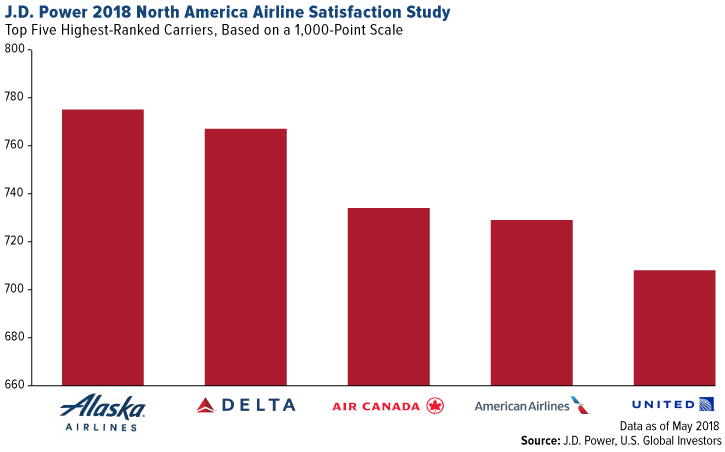
North American airline customers have spoken, and for the seventh straight year, passenger satisfaction has risen to a new all-time high. That’s according to the J.D. Power 2018 North America Airline Satisfaction Study, now in its 14th year. Among the contributing factors for the higher score were newer planes, lower costs and fees and larger overhead storage compartments.
On a 1,000-point scale, overall satisfaction climbed to a record series high of 762.
Alaska Airlines ranked highest among traditional North American airlines, scoring 775. This marks the Seattle-based carrier’s 11th consecutive year to place first. As for low-cost carriers, Southwest Airlines had the highest satisfaction, with a score of 818, its second straight year to lead the group.
The airlines that demonstrated the most improvement from the previous year were Allegiant Air, which gained 58 points to 725, and Air Canada, jumping ahead 25 points to 734.

“Never Been a Better Time to Fly”
Says Michael Taylor, J.D. Power’s Travel Practice Lead, “Operationally, it’s never been a better time to fly.”
Bold words. So what are the reasons why? According to Taylor, “checking in has never been easier” and “airlines have improved their baggage-handling performance.”
He has a point. In December 2013, the Transportation Security Administration (TSA) opened its first application center for PreCheck, the expedited screening program, and as of July 2017, more than five million travelers had enrolled and were enjoying the ease and convenience of skipping the long lines.
Baggage handling is also improving, as Taylor said. The number of mishandled bags on a global scale has fallen dramatically, from 18.88 bags per 1,000 passengers in 2007 to only 5.57 bags per 1,000 passengers in 2017, according to the Geneva-based Société Internationale de Télécommunications Aéronautiques (SITA). That’s an incredible 70.5 percent reduction—all while the total number of passengers surged 64 percent, from 2.48 billion in 2007 to 4.08 billion last year.
This has been good not just for passengers but also airlines, which have managed to save billions of dollars.
Record Number of Summer Travelers?
Because passenger satisfaction is up and the U.S. economy is booming, this summer could set a new record in terms of the number of air travelers. Airlines for America (A4A) predicts as many as 246.1 million passengers, an average of 2.68 million per day, to fly on U.S. carriers between June 1 and August 31. That’s up 3.7 percent from last summer.
Although it’s possible there’s been no better time to fly, as J.D. Power’s Michal Taylor puts it, we believe there’s been no better time to invest in airlines.
The U.S. Global Jets ETF (JETS) is the only airline-focused exchange-traded fund available today, making it a convenient “one-click” way to invest in the global airline market, which includes not just commercial carriers but also airline operators and manufacturers.
The fund tracks the U.S. Global Jets Index (JETSX), which is rebalanced and reconstituted quarterly using a quantamental, smart-beta approach.
It is not possible to invest directly in an index.
The J.D. Power North America Airline Satisfaction Study measures satisfaction with the entire air travel experience, from reservation to baggage retrieval, based on a recent flight experience. The study evaluates two market segments, low-cost carriers and traditional network carriers, and provides a competitive benchmark to measure customer advocacy and loyalty; identify improvement initiatives; and compare airline performance.
Beta is a measure of the volatility, or systematic risk, of a security or a portfolio in comparison to the market as a whole.
